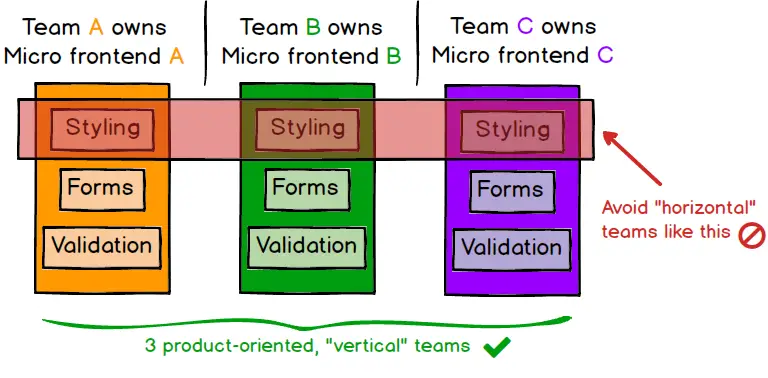Microfrontend Mix-ups: Implementing Microfrontends Effectively

While microfrontends offer many advantages, their implementation often presents challenges. This article highlights common pitfalls and provides guidance for implementing microfrontends effectively.

1. Overcomplicating the Architecture

Overcomplicating the microfrontend architecture can lead to confusion and maintenance issues. It is crucial to keep the design as simple and maintainable as possible. Avoid unnecessary layers and abstractions, and strive for a clean and cohesive structure.
2. Neglecting Communication Channels
Effective communication between microfrontends is essential. Neglecting to establish clear communication channels can result in data inconsistencies and performance issues. Define a communication protocol, such as event-based messaging or a shared state management system, to ensure seamless data exchange.
3. Ignoring Dependency Management
Microfrontends are autonomous components, but they often depend on shared libraries and resources. Failing to manage dependencies effectively can lead to conflicts and performance issues. Use a dependency management tool to track dependencies, ensure version compatibility, and avoid conflicts.
4. Underestimating the Importance of Testing
Testing is critical to ensure the reliability and compatibility of microfrontends. Neglecting to perform thorough testing can lead to bugs and performance issues. Establish a comprehensive testing strategy that includes unit testing, integration testing, and end-to-end testing.
5. Lack of Collaboration and Coordination
Implementing microfrontends often requires collaboration between multiple teams. Lack of coordination can lead to misalignment and inconsistencies. Establish clear communication channels, define responsibilities, and foster collaboration to ensure a smooth implementation process.
6. Insufficient Monitoring and Observability
Monitoring and observability tools are essential for tracking the performance and health of microfrontends. Failing to implement these tools can make it difficult to identify and resolve issues in a timely manner. Integrate monitoring tools to track metrics, logs, and errors to ensure proactive problem resolution.
7. Neglecting Security Considerations
Microfrontends introduce new security risks, as they increase the attack surface of the application. Neglecting security considerations can lead to vulnerabilities and data breaches. Implement robust security measures, such as authentication and authorization mechanisms, to protect microfrontends and sensitive user data.
Conclusion
By addressing these common pitfalls and following these guidelines, organizations can effectively implement microfrontends and reap their benefits. Keeping the architecture simple, establishing clear communication channels, managing dependencies effectively, testing thoroughly, fostering collaboration, implementing monitoring tools, and prioritizing security, teams can ensure successful microfrontend implementations.## Microfrontend Mix-ups: Implementing Microfrontends Effectively
Executive Summary
Microfrontends have emerged as a powerful architecture pattern for building and maintaining complex web applications. However, their implementation can be fraught with challenges if not approached strategically. This comprehensive guide will delve into the essentials of microfrontend implementation, addressing common pitfalls and providing practical guidance to ensure successful adoption.
Introduction
Microfrontends break down monolithic applications into smaller, independently developed and deployable modules, each负责a specific functionality. This approach offers numerous benefits, including scalability, flexibility, and improved development efficiency. However, it also introduces new complexities, requiring careful planning and execution to avoid common implementation pitfalls.
FAQs
1. What are the benefits of microfrontends?
- Increased scalability and flexibility
- Improved development efficiency
- Reduced maintenance costs
2. What are the challenges of implementing microfrontends?
- Managing dependencies and communication between modules
- Ensuring consistency across different teams
- Achieving optimal performance and resource utilization
3. How can I avoid common pitfalls?
- Thoroughly plan the architecture
- Use standardized communication protocols
- Pay attention to performance optimization
Subtopics
Architecture Considerations
- Module Granularity: Determine the appropriate size and scope of microfrontend modules based on functionality and dependencies.
- Communication Protocols: Select a communication mechanism (e.g., message bus, API gateways) that suits the specific architecture and application needs.
- Dependency Management: Implement robust mechanisms to handle dependencies between modules and coordinate updates to avoid conflicts.
Development Practices
- Collaboration and Coordination: Establish clear communication and coordination channels across development teams to ensure alignment and avoid duplication of efforts.
- Standardization and Guidelines: Define consistent coding practices, design standards, and testing procedures to maintain code quality and reduce debugging time.
- Testing and Monitoring: Implement comprehensive testing strategies to verify module functionality and monitor performance in production environments.
Performance Optimization
- Asynchronous Loading: Optimize module loading by using techniques such as code splitting and lazy loading to improve page performance.
- Resource Caching: Implement resource caching mechanisms to reduce HTTP requests and improve response times.
- Performance Monitoring: Monitor application performance metrics and identify bottlenecks to make informed optimizations.
Security Considerations
- Module Isolation: Isolate microfrontend modules from each other to prevent security vulnerabilities from spreading.
- Data Protection: Implement security measures to protect sensitive data and prevent unauthorized access.
- API Security: Secure API endpoints and enforce proper authorization and authentication to prevent unauthorized access to data.
Continuous Deployment and Maintenance
- Automated Deployment: Implement continuous deployment processes to automate the build, testing, and deployment of microfrontend modules.
- Version Management: Maintain a robust version management system to track changes, manage dependencies, and facilitate rollbacks.
- Monitoring and Logging: Establish comprehensive monitoring and logging systems to track application behavior, identify issues, and enable proactive maintenance.
Conclusion
Implementing microfrontends effectively requires a holistic approach that considers architecture, development practices, performance optimization, security, and continuous maintenance. By addressing common pitfalls, organizations can harness the full potential of microfrontends to build scalable, flexible, and high-performing web applications.
Keywords:
- Microfrontends
- Architecture
- Development Practices
- Performance Optimization
- Security
